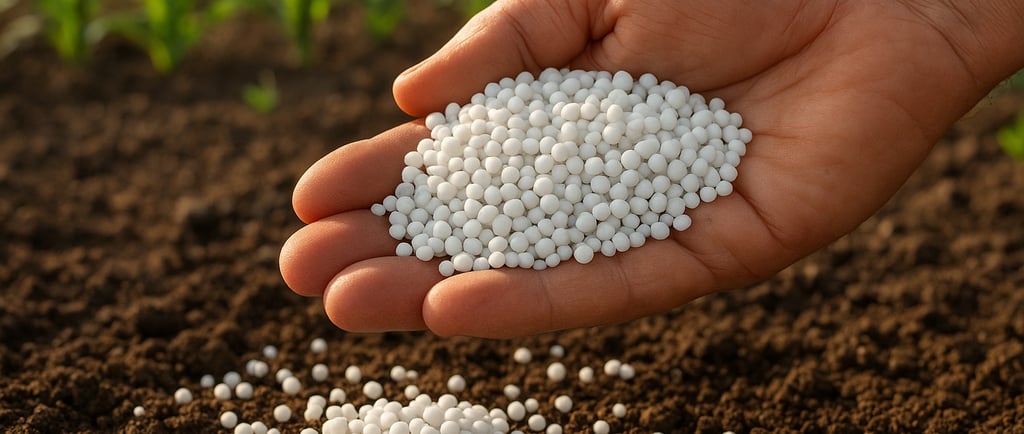Understanding DAP Fertilizer: Applications, Advantages, and Nano DAP
What is DAP Fertilizer? DAP, or Diammonium Phosphate, is a widely utilized fertilizer in modern agriculture, known for its high nutrient content and effectiveness in promoting plant growth. Composed of two main nutrients, nitrogen and phosphorus, it provides an essential source of nourishment for various crops, thereby significantly enhancing soil fertility.
FERTILIZER & NUTRIENT MANAGEMENT
8/14/20254 min read


What is DAP Fertilizer?
DAP, or Diammonium Phosphate, is a widely utilized fertilizer in modern agriculture, known for its high nutrient content and effectiveness in promoting plant growth. Composed of two main nutrients, nitrogen and phosphorus, it provides an essential source of nourishment for various crops, thereby significantly enhancing soil fertility. The chemical formula for DAP is (NH4)2HPO4, signifying its dual nature as a source of both ammonium and phosphate, which are crucial for plant development.
The role of DAP in agriculture cannot be overstated, as it facilitates many physiological processes within plants. Nitrogen is vital for the synthesis of amino acids and enzymes, playing a crucial role in vegetative growth. Phosphorus, on the other hand, is instrumental in energy transfer, photosynthesis, and the formation of DNA and RNA. By supplying these essential nutrients, DAP effectively supports root development, flowering, and fruiting, leading to improved yields and overall crop quality.
The production of DAP involves a two-step process, starting with the reaction of ammonia and phosphoric acid. This process results in the formation of DAP – a stable compound that can easily be granulated, allowing for ease of handling and application. DAP is available in various forms, primarily as granules, making it convenient for farmers to apply either manually or through modern fertilizer application equipment. Its solubility in water ensures that the nutrients are readily available for plants to absorb, further enhancing its efficacy as a fertilizer.
In summary, DAP fertilizer serves as a vital nutrient source for crops, contributing to enhanced soil fertility and promoting vigorous plant growth. Its chemical composition, production methods, and market availability underscore its significance in the agricultural sector.
Applications of DAP Fertilizer
DAP fertilizer, or diammonium phosphate, is a widely utilized nutrient source in agriculture, particularly known for its dual nitrogen and phosphorus content. It plays a crucial role in the early stages of plant growth, promoting robust root development and encouraging healthy foliage. DAP is often applied during planting, as it provides essential nutrients that are readily available during germination and early growth phases. This early application creates an optimal start for crops, leading to improved yields.
Various crops benefit significantly from the use of DAP fertilizer. Cereals, vegetables, fruits, and legumes are among the primary beneficiaries. For instance, cereals such as wheat and corn experience enhanced growth rates and increased drought resistance when DAP is utilized properly. Additionally, DAP is particularly advantageous for high-demand crops that require substantial phosphorus for fruitful development, making it a preferred choice for many farmers across different regions. Legumes, due to their unique root structures, can also effectively absorb the nutrients provided by DAP, supporting their growth and enhancing soil fertility through nitrogen fixation.
To maximize the effectiveness of DAP fertilizer, it is essential to consider ideal soil conditions. DAP performs best in neutral to slightly acidic soils, with a pH range of 6.0 to 7.5, allowing for optimal nutrient availability to plants. The application method can alter the efficacy of DAP; thus, broadcasting alongside planting or incorporating it into the soil are recommended practices. Additionally, banding DAP near the seed zone can improve its uptake, preventing nutrient loss to the surrounding area. Farmers should also monitor soil moisture levels and weather conditions when applying DAP to ensure optimal nutrient interaction and uptake by crops.
Advantages of Using DAP Fertilizer
The use of Di-Ammonium Phosphate (DAP) fertilizer offers several distinct advantages, primarily due to its high nutrient content and specific formulation. One of the key benefits of DAP is its rich composition, which contains approximately 18% nitrogen and 46% phosphorus, making it an effective source for these essential nutrients. The high phosphorus content is particularly significant as phosphorus plays an essential role in plant growth, contributing to root development, flowering, and overall crop health.
Another significant advantage of DAP fertilizer is its efficient release of nitrogen and phosphorus. When applied to the soil, DAP dissolves easily in water, allowing for quick uptake by plants. This rapid availability ensures that crops receive the necessary nutrients at critical growth stages, enhancing overall yield potential. By facilitating a balanced nutrient supply, DAP fertilizer can significantly improve crop productivity, leading to higher quality harvests and increased profitability for farmers.
Beyond its agronomic benefits, DAP fertilizer also contributes positively to sustainable agricultural practices when used responsibly. With its capacity to improve soil fertility and structure, DAP can aid in fostering long-term soil health. Additionally, several studies indicate that the application of DAP can reduce the likelihood of nutrient runoff into water bodies, thereby minimizing environmental impacts associated with agriculture. It is crucial, however, to apply DAP in appropriate amounts to prevent over-fertilization, which can lead to detrimental effects on both soil and water quality.
In summary, the advantages of using DAP fertilizer extend beyond mere nutrient provision. With its high content of essential nutrients, efficient release mechanisms, and potential environmental benefits, DAP plays a vital role in modern agriculture, supporting sustainable practices while boosting crop yields and farmers' profitability. Proper management and application strategies are key to fully realizing its benefits.
Nano DAP (Diammonium Phosphate in nano form) fertilizer
Nano DAP is a liquid fertilizer developed using nanotechnology, where the DAP particles are extremely small (in nanometers). This increases their surface area and absorption efficiency, so plants require less quantity compared to conventional granular DAP.
Key points about Nano DAP:
Nutrient composition: Around 8% nitrogen (N) and 16% phosphorus (P₂O₅) in liquid nano form.
Application: Usually sprayed on leaves (foliar application) or used in drip irrigation.
Benefits:
Higher nutrient-use efficiency (up to 80–85%).
Reduces fertilizer wastage and environmental pollution.
Lightweight and easy to transport compared to 50 kg DAP bags.
Helps reduce India’s dependency on imported fertilizers.
Dosage: Often 2–4 ml per liter of water for foliar spray (varies by crop stage).


"Boosting Crop Growth With Nature's Power"
Contact Us:
E Mail: support@frosil.com
Customer Care: +91 8329592991
FROSIL © 2025. All rights reserved.


'Frosil' is a fertilizer manufacturer committed to enhancing soil health and crop yields. We provide high-quality, eco-friendly products that support sustainable agriculture and help farmers achieve optimal results.
Registered Office: Gat No.96, Near Krushnai Hospital, Tandali. Tal- Shirur, Dist- Pune.
